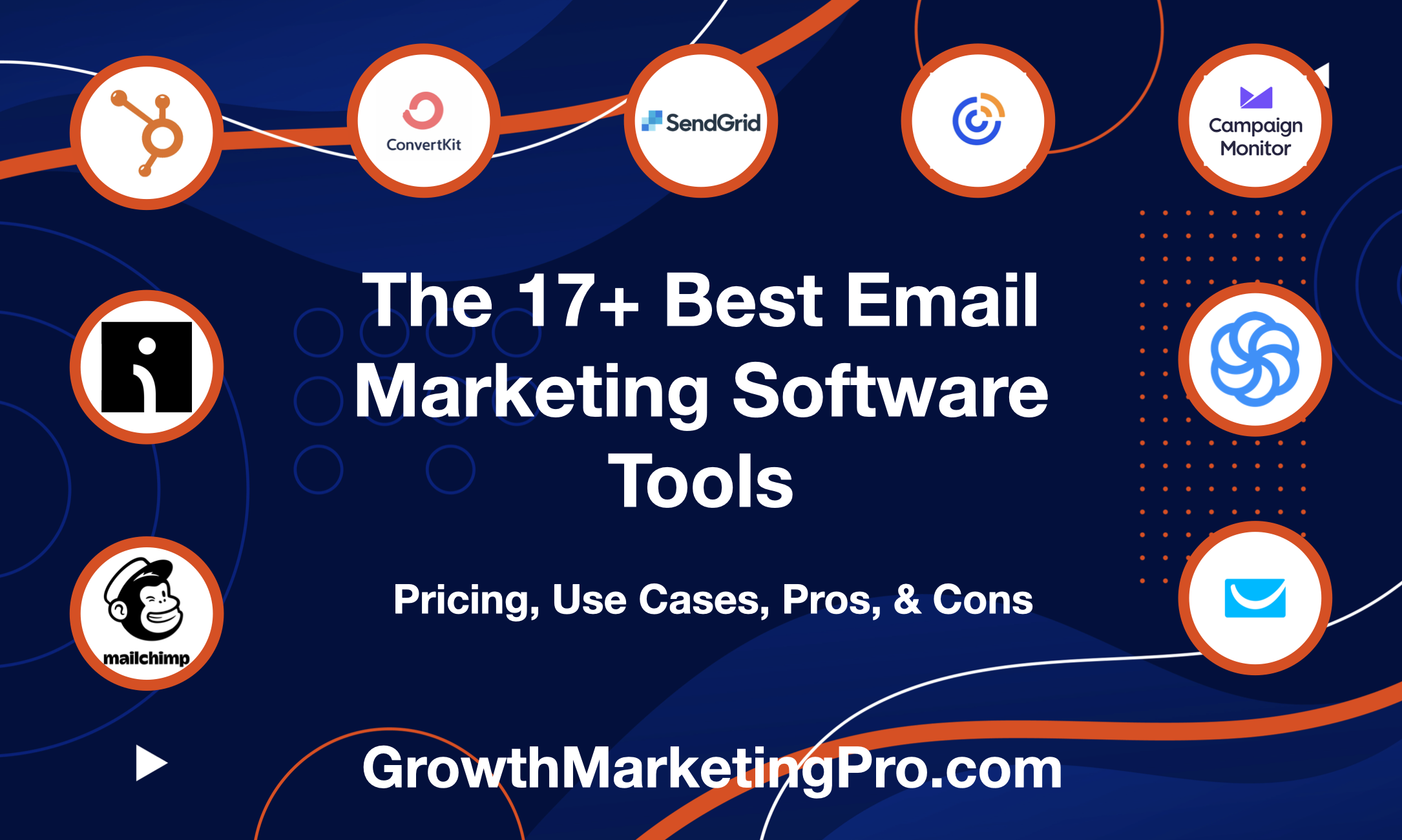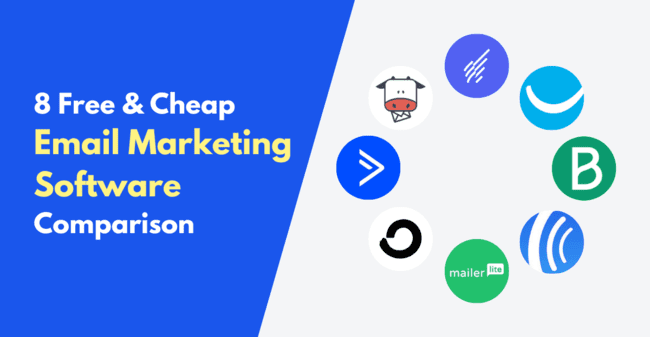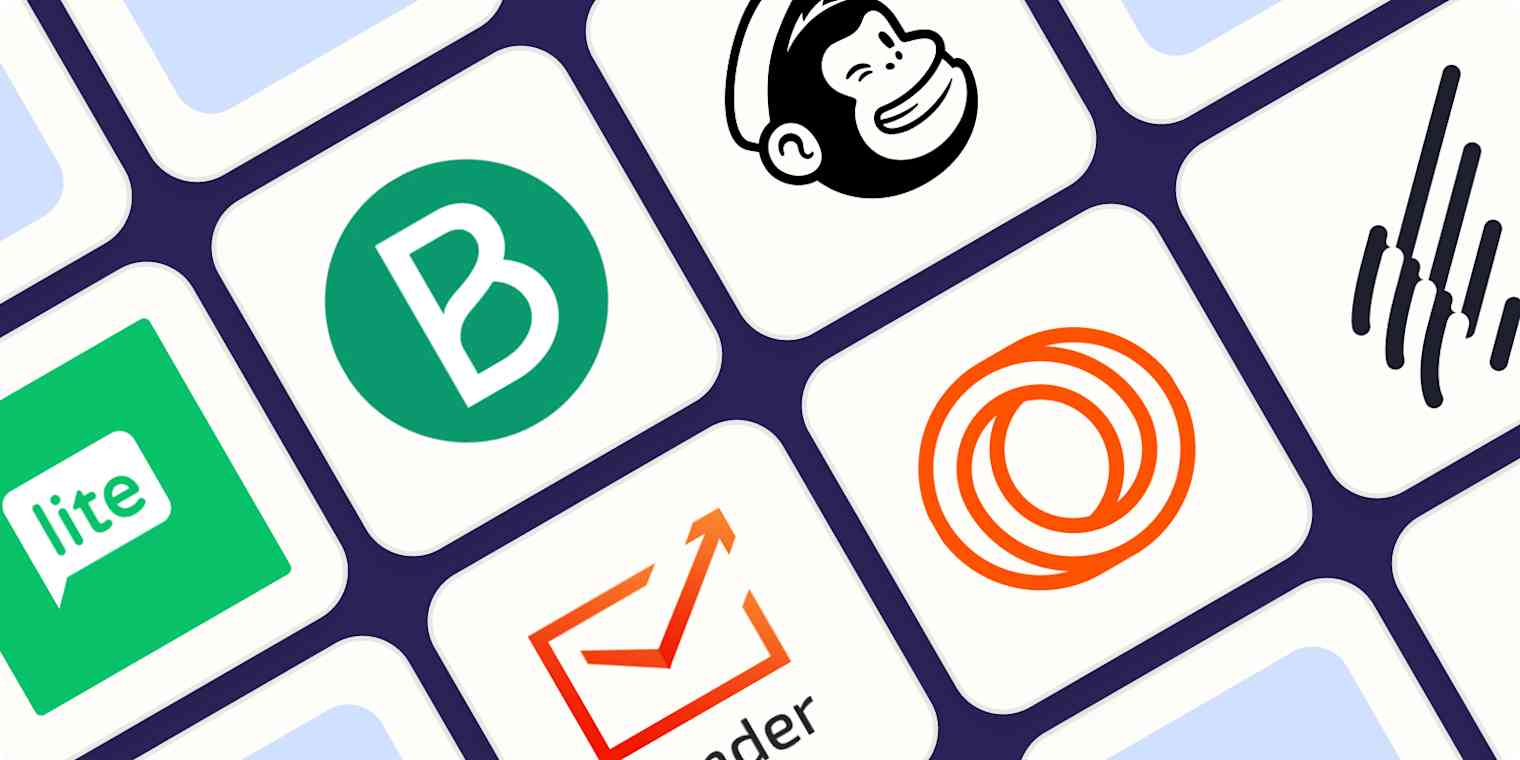Email Marketing Software Tools streamline the process of creating, sending, and analyzing email campaigns. They help businesses reach and engage their target audiences effectively.
| Tool | Description | Price | Visit Site |
|---|---|---|---|
| Mailchimp | Comprehensive email marketing with automation, templates, and analytics. Includes basic AI for recommendations. | Free, Paid plans from $299/month | visit site |
| Sendinblue | Email marketing and SMS with automation and segmentation features. Offers AI-based send-time optimization. | Free, Paid plans from $65/month | visit site |
| Constant Contact | User-friendly tool with event marketing and social media integration. Limited AI for recommendations. | Paid plans $9.99 – $45/month | visit site |
| ActiveCampaign | Advanced automation, CRM, and customer experience tools. Uses machine learning for predictive analytics. | Paid plans $29 – $149/month | visit site |
| Klaviyo | Targeted email and SMS marketing for eCommerce. Features AI-driven product recommendations. | Free, Paid plans from $700/month | visit site |
| GetResponse | Email marketing, landing pages, and webinars combined. Has AI-powered recommendations. | Paid plans $19 – $119/month | visit site |
| HubSpot | Comprehensive inbound marketing and CRM platform. Includes AI for segmentation and automation. | Free, Paid plans from Custom Pricing | visit site |
| Benchmark Email | Simple drag-and-drop email marketing solution. No AI features. | Free, Paid plans from $45/month | visit site |
| Zoho Campaigns | Part of Zoho Suite with integration to other business tools. Basic AI for suggestions. | Free, Paid plans from $25/month | visit site |
| Brevo | Advanced segmentation, automation, and personalization capabilities. Features AI-driven send-time optimization. | Free, Paid plans from $83/month | visit site |
Email marketing software tools are essential for businesses aiming to enhance their marketing efforts. These tools offer features like automation, segmentation, and analytics, making it easier to manage email campaigns. Automation saves time by scheduling emails and sending them based on user behavior.
Segmentation ensures that messages are tailored to specific audience groups, increasing engagement rates. Analytics provide insights into campaign performance, helping refine strategies. By leveraging these tools, businesses can build stronger relationships with their customers, improve conversion rates, and achieve better overall marketing results.
Introduction To Email Marketing
Email marketing is a powerful tool for businesses. It helps them connect with their audience. This strategy involves sending emails to customers and prospects. These emails can be promotional, informational, or transactional.
Using email marketing, businesses can build relationships. They can also drive sales and improve customer retention. This method is cost-effective and highly targeted. It’s essential for any modern digital marketing strategy.
Importance Of Email Marketing
Email marketing offers numerous benefits. Here are some key points:
- Cost-effective: Sending emails is cheaper than other marketing methods.
- Targeted: Emails can be personalized for specific audiences.
- Measurable: Track open rates, click rates, and conversions easily.
- Engagement: Email keeps customers informed and engaged with your brand.
Email marketing is also versatile. It can support other marketing channels. For example, use email to promote social media campaigns or blog posts. This integration boosts overall marketing efforts.
Current Trends
Email marketing is evolving. Here are some current trends:
- Automation: Automated emails save time and increase efficiency.
- Personalization: Personalized emails improve engagement and conversion rates.
- Interactive Emails: Adding interactive elements makes emails more engaging.
- Mobile Optimization: Emails must look good on mobile devices.
- AI and Machine Learning: These technologies help optimize email campaigns.
Staying updated with these trends is crucial. It ensures your email marketing efforts remain effective and relevant.

Credit: www.growthmarketingpro.com
Key Features To Look For
Choosing the right email marketing software can be challenging. But knowing the key features to look for can make it easier. Below are the essential features that can significantly enhance your email marketing campaigns.
Automation Capabilities
Email automation is a game-changer for marketers. It helps save time and ensures messages reach the right audience at the right time. Here are some critical automation features to consider:
- Drip Campaigns: Send a series of emails based on user actions.
- Welcome Emails: Automatically send a greeting email to new subscribers.
- Behavioral Triggers: Send emails based on specific user activities.
- Personalization: Include the recipient’s name and other personal details.
Segmentation Options
Segmentation allows you to divide your email list into smaller groups. This helps in sending more targeted and relevant emails. Key segmentation features to look for include:
- Demographics: Segment based on age, gender, location, etc.
- Behavioral Data: Segment based on past interactions and purchase history.
- Engagement Levels: Segment based on how often users open your emails.
- Custom Tags: Add custom tags to categorize your subscribers.
Using these segmentation options can improve your email open rates. It also increases your overall engagement.
Top Email Marketing Tools
Email marketing can boost your business. It helps engage and retain customers. Using the right email marketing tools can make a big difference. These tools offer various features. They enhance your campaigns and make them more effective.
Overview Of Popular Tools
There are many email marketing tools available. Each tool offers unique features. Here are some of the most popular ones:
- Mailchimp: Known for its user-friendly interface. It offers automation, templates, and analytics.
- Constant Contact: Great for beginners. It provides templates, social media integration, and reporting.
- Sendinblue: Offers SMS marketing and email automation. It also has a CRM feature.
- AWeber: Known for its customer support. It provides easy-to-use templates and automation.
- GetResponse: Offers marketing automation, webinars, and CRM. It is suitable for both small and large businesses.
Comparative Analysis
Choosing the right tool depends on your needs. Here is a comparison of the top tools:
| Feature | Mailchimp | Constant Contact | Sendinblue | AWeber | GetResponse |
|---|---|---|---|---|---|
| User-Friendly | ⭐⭐⭐⭐⭐ | ⭐⭐⭐⭐⭐ | ⭐⭐⭐⭐ | ⭐⭐⭐⭐ | ⭐⭐⭐⭐ |
| Automation | ⭐⭐⭐⭐ | ⭐⭐⭐ | ⭐⭐⭐⭐⭐ | ⭐⭐⭐⭐ | ⭐⭐⭐⭐⭐ |
| Templates | ⭐⭐⭐⭐⭐ | ⭐⭐⭐⭐ | ⭐⭐⭐⭐ | ⭐⭐⭐⭐ | ⭐⭐⭐⭐ |
| Customer Support | ⭐⭐⭐⭐ | ⭐⭐⭐⭐ | ⭐⭐⭐⭐ | ⭐⭐⭐⭐⭐ | ⭐⭐⭐⭐ |
| Additional Features | ⭐⭐⭐⭐ | ⭐⭐⭐ | ⭐⭐⭐⭐⭐ | ⭐⭐⭐⭐ | ⭐⭐⭐⭐⭐ |
Choose the tool that fits your business. Consider features like user-friendliness, automation, templates, and support.
Benefits Of Using Email Marketing Software
Email marketing software brings many benefits for businesses. These tools simplify marketing tasks. They also help create personalized experiences. Below are some key advantages:
Improved Efficiency
Email marketing software saves time. You can automate campaigns. This means emails are sent automatically. No need to send each email manually. You can also schedule emails in advance. This makes planning easier.
These tools offer templates. You don’t need to design each email from scratch. Just pick a template and customize it. This speeds up the creation process. You can also track email performance. See which emails get opened. Understand what content works best.
Here is a table of efficiency benefits:
| Feature | Benefit |
|---|---|
| Automation | Saves time |
| Scheduling | Easy planning |
| Templates | Speeds up creation |
| Tracking | Improve content |
Enhanced Personalization
Personalization boosts engagement. Email marketing software lets you personalize easily. You can use customer data to tailor emails. This makes each email feel unique. Personalized emails get more attention.
Here are some ways you can personalize emails:
- Use the recipient’s name
- Segment email lists by interest
- Send special offers based on past purchases
These small touches make a big difference. Customers feel valued. They are more likely to open and read your emails. Enhanced personalization leads to better results.
Email marketing software tools are a game-changer. They make your marketing efforts more efficient. They also help create a personal touch. Embrace these tools for better engagement and results.
How To Choose The Right Tool
Finding the perfect email marketing software tool can be daunting. There are many options. You need to consider your business needs and budget. This guide will help you make the right choice.
Business Needs Assessment
First, assess your business needs. What are your goals? Do you need automated campaigns? Are analytics important? List all your requirements.
- Automated campaigns
- Analytics and reporting
- Customizable templates
- Integration with other tools
Next, think about your team. Do they need an easy-to-use tool? Will they need training? Make sure the tool fits your team’s skills.
Budget Considerations
Check your budget. Email marketing tools come in different price ranges. Some are free, some cost a lot. Decide how much you can spend.
| Price Range | Features |
|---|---|
| Free | Basic templates, limited subscribers |
| $10 – $50/month | More templates, automation, analytics |
| $50+/month | Advanced features, unlimited subscribers |
Compare different tools within your budget. Look at the features they offer. Choose the one that meets your needs and fits your budget.
Use this guide to find the best email marketing software tool for your business. Make sure it fits your business needs and budget. Happy emailing!
Best Practices For Email Campaigns
Email campaigns can boost your business if done correctly. Following best practices ensures your messages are effective and well-received.
Crafting Effective Subject Lines
The subject line is the first thing your audience sees. It needs to grab attention and encourage opens.
- Keep it short: Aim for 50 characters or less.
- Use action words: Words like “Discover” or “Learn” can be engaging.
- Personalize: Include the recipient’s name or relevant details.
- Avoid spam triggers: Words like “Free” or excessive punctuation can hurt.
Using these tips can increase open rates and engagement.
Optimal Send Times
Sending your emails at the right time can make a big difference. Knowing your audience’s habits helps.
| Day | Best Time |
|---|---|
| Monday | 8 AM – 10 AM |
| Tuesday | 10 AM – 12 PM |
| Wednesday | 2 PM – 4 PM |
| Thursday | 8 AM – 10 AM |
| Friday | 12 PM – 2 PM |
Test different times to see what works best for your audience.
Using analytics can help you refine your strategy.
Metrics To Track Success
Email marketing software tools are essential for modern businesses. They help you connect with your audience and measure your success. Tracking the right metrics is key. These metrics show you what’s working and what needs improvement. Below are some important metrics to track for email marketing success.
Open Rates
Open rates tell you how many people opened your email. This metric is crucial. It shows your subject line’s effectiveness. If your open rate is low, try changing the subject line. Make it more engaging. Personalize it if possible. Use emojis to grab attention. A good open rate is around 20-30%.
Click-through Rates
Click-through rates (CTR) measure the number of clicks on links in your email. This metric shows how engaging your content is. If your CTR is low, improve your call-to-action (CTA). Make your links stand out. Use buttons instead of text links. A good CTR is around 2-5%.
| Metric | What It Measures | Good Percentage |
|---|---|---|
| Open Rate | Percentage of opened emails | 20-30% |
| Click-Through Rate | Percentage of clicks on email links | 2-5% |
- Open Rate: Indicates subject line effectiveness.
- Click-Through Rate: Shows content engagement level.

Credit: www.emailvendorselection.com
Case Studies And Success Stories
Email marketing software tools have transformed how businesses connect with customers. Real-life examples and success stories illustrate their impact. These stories show the power of email marketing tools in driving business growth.
Real-life Examples
Many businesses have seen significant growth using email marketing software. Let’s explore a few real-life examples:
| Company | Challenge | Solution | Result |
|---|---|---|---|
| ABC Retail | Low engagement rates | Personalized email campaigns | 30% increase in open rates |
| XYZ Services | High unsubscribe rates | Targeted content | 15% reduction in unsubscribes |
| 123 Tech | Poor customer retention | Automated follow-ups | 20% increase in customer retention |
Lessons Learned
These success stories teach valuable lessons for email marketing:
- Personalization is key to boosting engagement. Tailored messages resonate more with recipients.
- Targeted content reduces unsubscribe rates. Relevant emails keep customers interested.
- Automation helps in customer retention. Timely follow-ups maintain customer relationships.
Implementing these strategies can lead to better results with email marketing. Businesses can grow by learning from these success stories.
Future Of Email Marketing
Email marketing is evolving. New technologies and trends are shaping its future. Let’s explore these exciting changes.
Emerging Technologies
Artificial Intelligence (AI) is revolutionizing email marketing. AI can personalize email content. It analyzes user behavior and preferences.
Machine learning helps in predicting user actions. This makes emails more relevant. AI-powered tools can write subject lines. They optimize send times for better engagement.
Automation is also on the rise. Automated workflows save time. They ensure timely communication with customers. This boosts efficiency and effectiveness.
Interactive Emails are gaining popularity. These emails include features like carousels, sliders, and forms. Users can interact without leaving the email. This improves user experience and engagement.
Predicted Trends
Several trends will dominate the future of email marketing. Here are a few key ones:
- Hyper-Personalization: Emails will be more tailored to individual users. AI will play a big role in this.
- Mobile Optimization: More people are checking emails on mobile devices. Mobile-friendly designs will be crucial.
- Data Privacy: Stricter regulations will come into play. Companies must prioritize user consent and data protection.
- Visual Content: Videos and gifs in emails will become common. This makes emails more engaging.
Future email marketing will be driven by technology and user preferences. Staying updated with these trends is essential for success.

Credit: zapier.com
Frequently Asked Questions
What Is Email Marketing Software?
Email marketing software is a tool that helps businesses send promotional emails. It automates email campaigns and tracks performance metrics.
How Does Email Marketing Software Work?
Email marketing software automates sending emails to your audience. It personalizes messages, schedules emails, and tracks open rates and clicks.
Why Use Email Marketing Software?
Email marketing software saves time and improves efficiency. It enhances targeting and personalization, leading to higher engagement and conversions.
Can Email Marketing Software Improve Sales?
Yes, email marketing software can improve sales. It targets specific audiences with personalized messages, increasing conversion rates.
Conclusion
Choosing the right email marketing software is crucial for your business success. These tools streamline your campaigns and boost engagement. Evaluate your needs and budget to find the best fit. With the right software, you can enhance communication and grow your audience effectively.
Start exploring your options today.














